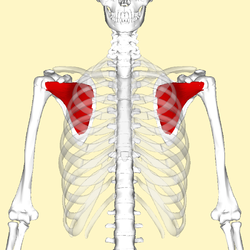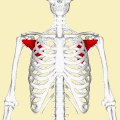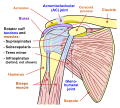Mack et al. developed an ultrasonographic procedure with which it is possible to explore almost the complete rotator cuff within six steps. It unveils clearly the whole area from the subedge of the subscapularis tendon until the intersection between the infraspinatus tendon and musculus teres minor. One of six steps does focus on the subscapularis tendon. In the first instance the examinator guides the applicator to the proximal humerus as perpendicularly as possible to the sulcus intertubercularis. Gliding now medially shows the insertion of the subscapularis tendon. [6]
Longitudinal plane of the musculus subscapularis and its tendon
The subscapularis tendon lies approximately 3 to 5 cm under the surface. Quite deep for ultrasonography, and therefore displaying through a highly penetrative 5 MHz linear applicator is worth a try. And it really turned out to ease a detailed examination of the muscle which just abuts to the scapula. However, the tendon of primary interest does not get mapped as closely as desired. As anatomical analysis showed, it is only by external rotation possible to see the ventral part of the joint socket and its labrum. While at the neutral position the tuberculum minus occludes the view. Summing up it is through an external arm rotation and a medially applied 5 MHz sector sonic head possible to display the ventral part of the joint socket and its labrum with notedly lower echogenicity. [7]
The following sectional planes are defined for the sonographic examination of the different shoulder joint structures: [8]
| Ventral transversal | Ventral sagittal medial | Ventral sagittal lateral | Lateral coronal | Lateral transversal/sagittal: | Dorsal transversal | Dorsal sagittal |
|---|
| subscapularis muscle (longitudinal) | subscapularis muscle (transversal) | Intertub. sulcus with long head of biceps brachii (longitudinal) | supraspinatus muscle (longitudinal) | supraspinatus muscle (transversal) | infraspinatus muscle (longitudinal) | supraspinatus muscle (transversal) |
| Intertubercular sulcus with long head of biceps brachii (transversal) | | | | | Hill-Sachs-Lesio | |
Tissue harmonic imaging
Primarily in abdominal imaging, tissue harmonic imaging (THI) gets more and more valued and used additionally to conventional ultrasonography.
THI involves the use of harmonic frequencies that originate within the tissue as a result of nonlinear wave front propagation and are not present in the incident beam. These harmonic signals may arise differently at anatomic sites with similar impedances and thus lead to higher contrast resolution." Along with higher contrast resolution it has an elevated signal-to-noise ratio and significantly reduced inter- and intraobserver variability compared with conventional US. Additionally it is possible to nearly eliminate ordinary US artifacts, i.e. side-lobe, near-field artifacts, reverberation artifacts. As aforementioned THI has already led to enhanced abdominal, breast, vascular and cardiac sonography.
For musculo-skeletal aspects THI has not been used that much, although this method features some useful potential. For example, for the still tricky discrimination between the presence of a hypoechoic defect and/or loss of the outer tendon convexity/non-visualization of the tendon, that is between partial- and full-thickness rotator cuff tears.
In comparison to a checking MR Arthrography Strobel K. et al. has arrived at the conclusion that through THI it is possible to achieve a generally improved visibility of joint and tendon surfaces, especially superior for subscapularis tendon abnormalities. [9]






